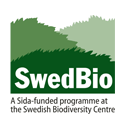Click on images to enlarge
_-_Spotted_Stemborer/thumbs/Chpartellus_lifecycle_sml.jpg)
Lifecycle of Chilo partellus - from icipe. Source: http://harvestchoice.org/production/biotic/pest_profiles/chilo_partellus
_-_Spotted_Stemborer/thumbs/Chpartellus_adult2_sml.jpg)
Chilo partellus adult. ©Stemborer team, icipe.
_-_Spotted_Stemborer/thumbs/Chpartellus_damage_early_sml.jpg)
Early damage to maize by Chilo partellus larva. ©Stemborer team, icipe
_-_Spotted_Stemborer/thumbs/Chpartellus_larva3_sml.jpg)
Larva of Chilo partellus. ©Stemborer team, icipe
_-_Spotted_Stemborer/thumbs/chilo_partellus01_sml.jpg)
Chilo partellus adult moth, set specimen. ©Georg Goergen (source CABI CPC)
Summary
The spotted stemborer is native to Asia and became established in Africa in the 1950s. It occurs at low to medium altitudes. The spotted stemborer attacks several grass species, both wild and cultivated (including maize, sorghum, pearl millet and rice). The larvae (caterpillars) eat through leaves when young and as they grow older, eventually bore into the stem causing it to break or die.
Common Names
Spotted stemborer
Synonyms
Chilo zonellus (Swinhoe, 1884);Argyria lutulentalis Tams, 1932
Taxonomic Position
Phylum: Arthropoda; Class: Hexapoda (Insecta);Order: Lepidoptera;Family: Crambidae
Origin and Distribution
The spotted stemborer is native to Asia where it is a pest of maize and sorghum. it was first reported from Africa in the 1930s and became established in East Africa in the 1950s. It is now widespread throughout eastern and southern Africa and may also now occur in western Africa. It occurs in low to mid-altitude areas (1230 m altitude and below).
Description
Eggs
Are flat and oval (scale-like), creamy-white, about 0.8mm long, laid in overlapping batches of 10-80 eggs on the upper and underside leaf surfaces, mainly near the midribs.
Spotted stem borer larvae (caterpillars) are creamy-white to yellowish-brown in colour, with four purple-brown longitudinal stripes and usually with very conspicuous dark-brown spots along the back, which give the larvae a spotted appearance (hence the common name). When fully grown the larva has a prominent reddish-brown head. It has a prothoracic shield (a plate on the dorsal surface of the thorax ) which is reddish-brown to dark-brown and shiny.
Pupae
Are up to 15 mm long, slender, shiny and light yellow-brown to dark red-brown in colour.
Adults
Are relatively small moths with wing lengths ranging from 7-17 mm and a wingspan of 20-25 mm. Forewings are brown-yellowish with darker scale patterns forming longitudinal stripes. In males, hind wings are a pale straw-colour, and in females, they are white.
Similar Species
In external appearance the spotted stemborer (Chilo partellus) resembles many other species of Chilo but can be distinguished from them by diagnostic characters of the male and female genitalia, which may require taxonomic expertise. In East Africa, it may be confused with the coastal stemborer (Chilo orichalcociliellus).
Life Cycle
Eggs are laid in batches on leaf surfaces, usually close to the midrib. They hatch after 4-10 days.
Young caterpillars initially feed in the leaf whorl. Older caterpillars tunnel into stems, eating out extensive galleries, within which they feed and grow for 2-3 weeks. When larvae are fully grown, they pupate and remain inside the maize stem. After 7-14 days adults emerge from pupae and come out of the stem. They mate and lay eggs on maize plants again and continue damaging the crop. During the dry season, larvae may enter a state of suspended development (diapause ) for several months and will only pupate with the onset of rains. Adults emerge from pupae in the late afternoon or early evening. They are active at night and rest on plants and plant debris during the day. They are rarely seen, during the day unless they are disturbed.
The whole life cycle takes about 3-4 weeks, varying according to temperature and other factors. Five or more successive generations may develop in favourable conditions. In regions where there is sufficient water and an abundance of host plants, the spotted stemborer can reproduce and develop all year-round.
Pest Destructive Stage
Larvae (caterpillars) eat through leaves when young and as they grow older, eventually bore into the stem causing it to break (lodge) or die resulting in a condition called 'deadheart'.
Host Range
The spotted stemborer attacks several grass species, both cultivated and wild.
Cultivated crop hosts include maize, sorghum, pearl millet, rice and sugarcane.
Wild hosts include many species of wild grasses such as: elephant grass (Pennisetum purpureum), reeds (Phragmites species) and vossia (Vossia cuspidate).
Host Lifestage Affected
Vegetative stage or before harvest. Younger plants less than two months old are more often attacked than older plants.
Host Plant Part Affected
Feeding by younger larvae takes place in leaf whorls. Older larvae tunnel into the stem, and may also eat into the cob in older plants. Yield losses are variable across regions, seasons, plant species and varieties and management regime on farms. Yield losses may exceed 20% on maize and 50% on sorghum.
Damage Symptoms
Damage occurs as a series of small holes in lines (pin holes) in younger leaves and/or patches of transparent leaf epidermis (window panes) in older leaves. Holes in stem caused by larvae tunnelling into the stem can result in broken stems or drying and eventual death of the growing point of the maize (deadheart).
Pest Management
Detection methods
Spotted Stemborer infestations may be detected by walking through young crops looking for characteristic feeding marks on funnel leaves, the presence of dead hearts and holes in tunnelled stems. Samples of affected stems can be cut open to find caterpillars and pupae. It is best to rear them until they reach the adult stage to identify the species as it is very difficult to identify the species from the larvae and pupae. Spotted stemborers may be detected in older crops and in crop residues by taking random samples of stems to dissect to find caterpillars and pupae.
Cultural practices
Intercropping maize with non-hosts crops like cassava or legumes like cowpea can reduce spotted stemborer damage. Alternatively, maize can be intercropped with a repellent plant such as silver leaf desmodium (Desmodium uncinatum) and a trap plant, such as Napier grass (Pennisetum purpureum), molasses grass (Melinis minutiflora) as a border crop around this intercrop to protect maize from stemborers. The trap plant draws the adult female away from the crop. More eggs are laid on the trap plant than on the crop but the larvae develop poorly or not at all on the trap plant. This practice is known as "push-pull".
Good crop hygiene through the destruction of maize residues by burning to get rid of the larvae and pupae within the stems, and removal of volunteer crop plants and/or alternative hosts, prevents carry-over populations. This helps in limiting the initial establishment of stemborers that would infest the next crop.
Early slashing of maize stubble and laying it out on the ground where the sun's heat destroys the larvae and pupae within can also be utilised.
Biological control
Biological control by two parasitic wasps, Cotesia flavipes and Xanthopimpla stemmator, that attack the spotted stemborer, has shown good results. Cotesia flavipes locates the stemborers while they are feeding inside the plant stems. The wasp lays about 40 eggs into a stemborer. Upon hatching the larvae of the parasitic wasp feed internally in the stemborer, and then exits and spin cocoons. Xanthopimpla stemmator operates similarly but attacks the pupae. Habitat management practices that conserve these parasitoids and predators like ants and earwigs can help in the control of the spotted stemborer.
Chemical control
Chemical control can be achieved by applications of granules or dusts to the leaf whorl early in crop growth to kill early larval instars. This method has limited effectiveness once the larvae bore into the stem. Neem products (powder from ground neem seeds) are reportedly effective and may be applied to the leaf whorl in a 1:1 mixture with dry clay or sawdust. Pesticides are poisons so it is essential to follow all safety precautions on labels.
Sources of Information and Links
Spotted stemborer. Infonet-Biovision, http://www.infonet-biovision.org. Accessed January 2011.
CAB International 2006. Crop Protection Compendium. Wallingford, UK, CAB International. Accessed February 8th 2011.
Kfir R., Overholt W.A., Khan Z.R. and Polaszek A. (2002). Biology and management of economically important lepidopteran cereal stem borers in Africa. Annual Review of Entomology, 47: 701-731.
Overholt W.A, Maes K.V.N and Goebel F.R. (2001). Field guide to the stemborer larvae of maize, sorghum and sugarcane in Eastern and Southern Africa. ICIPE Science Press, Nairobi, Kenya.
Polaszek A. (ed.) (1998). African cereal stemborers; economic importance, taxonomy, natural enemies and control. CAB International, Wallingford, Oxon, UK. 530pp.
Seshu Reddy K.V. (1983). Studies on the stemborer complex in Kenya. Insect Science and its Application 4: 3-10.
Editors
Anne M. Akol, Makerere University; Maneno Y. Chidege, Tropical Pesticides Research Institute; Herbert A.L. Talwana, Makerere University; John R. Mauremootoo, BioNET-INTERNATIONAL Secretariat.
Acknowledgments
We recognise the support from the National Museums of Kenya, Tropical Pesticides Research Institute (TPRI) - Tanzania and Makerere University, Uganda. This activity was undertaken as part of the BioNET-EAFRINET UVIMA Project (Taxonomy for Development in East Africa).
Contact
BioNET-EAFRINET Regional Coordinator: [email protected]












